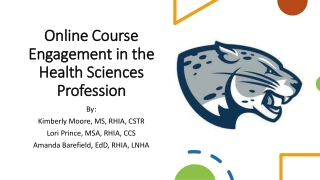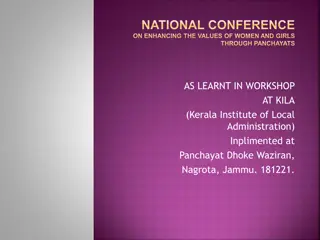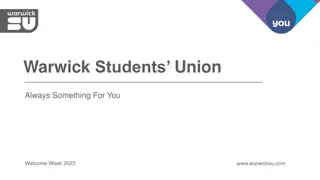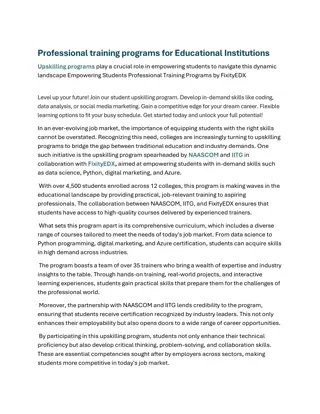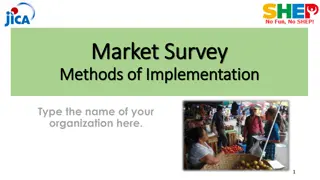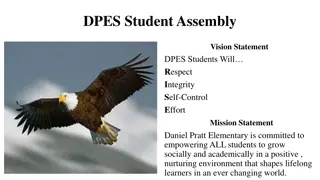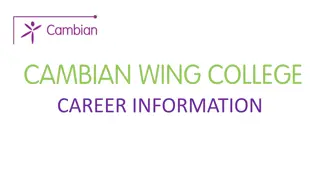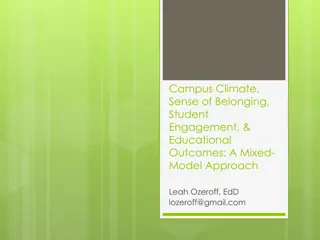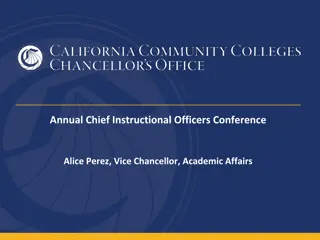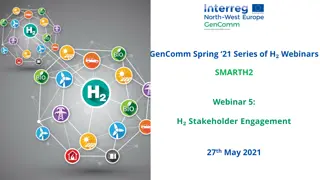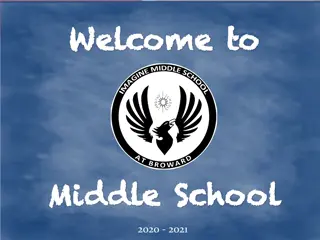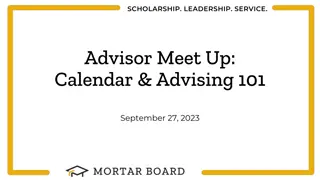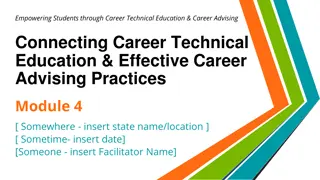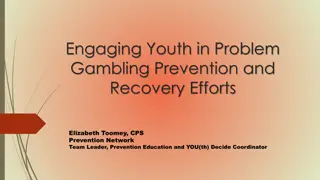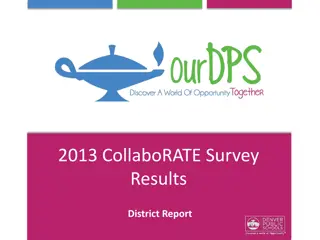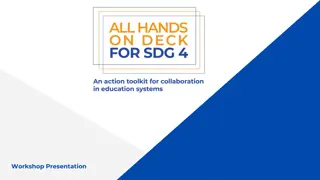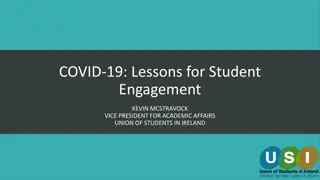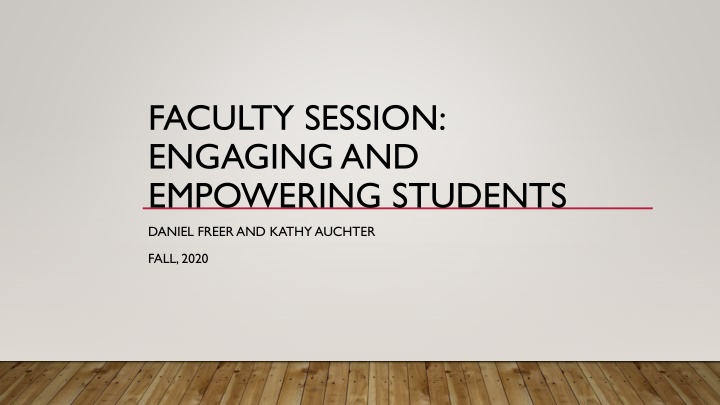
Effective Strategies for Engaging and Empowering Online Students in Fall 2020
Discover evidence-based pedagogy practices and recommendations for engaging and empowering students in online courses during Fall 2020. Explore topics such as instructor-student interactions, group activities, formative assessments, and more. Get insights on preparing for blended learning and addressing specific departmental questions.
Download Presentation

Please find below an Image/Link to download the presentation.
The content on the website is provided AS IS for your information and personal use only. It may not be sold, licensed, or shared on other websites without obtaining consent from the author. If you encounter any issues during the download, it is possible that the publisher has removed the file from their server.
You are allowed to download the files provided on this website for personal or commercial use, subject to the condition that they are used lawfully. All files are the property of their respective owners.
The content on the website is provided AS IS for your information and personal use only. It may not be sold, licensed, or shared on other websites without obtaining consent from the author.
E N D
Presentation Transcript
FACULTY SESSION: ENGAGING AND EMPOWERING STUDENTS DANIEL FREER AND KATHY AUCHTER FALL, 2020
AGENDA Current context Strategies for three types of online-student engagement: (1) instructor-student, (2) student- student, and (3) student-content Instructor presence Course norms/netiquette Frequent formative assessments Variability in your course resources Group activities Online course template Q&A
CURRENT CONTEXT: INSTRUCTIONAL STRATEGY RECOMMENDED FOR FALL, 2020 Optimistic about resuming in person Fall, 2020; but it won t be typical: social distancing health guidelines populations that cannot be on campus (high risk students, international students Possible quarantined populations Classroom census: ID room capacity give social distancing ID logistics of movement and sanitation ID what courses are highly dependent on f2f expected to be done at the end of June
SPECIFIC COURSE &/OR DEPARTMENT QUESTIONS Speak with your department chair for any questions related to: accommodations course schedule course modality
CURRENT CONTEXT: ONLINE COMPONENT PREPARE FOR BLENDED Inevitable online course component at least blended/flipped classroom Not 2 separate courses 1 course that can be accessed online and/or f2f Online course template (d2l) Strategies to engage and empower students
ENGAGEMENT RATIONAL Evidenced-based best online pedagogy practices Marquette s Spring, 2020 shift-to-online student survey: Students want/need more: Engagement; Consistency; Interaction; and Guidance.
ENGAGEMENT-RATIONAL RESPONSE Online course template: MU's DDL created to help you build your online and blended courses in D2L customizable includes examples and suggestions on how to organize content includes examples and suggestions on how to enagage, support, and guide online students provides consistency
TYPES OF ENGAGEMENT INSTRUCTOR STUDENT STUDENT STUDENT CONTENT - STUDENT
INSTRUCTOR-STUDENT ENGAGEMENT: INSTRUCTOR PRESENCE GETTING STARTED Reach out to your students before the class begins Email and News item Set the tone for participation course norms and netiquette Start Here module in online course template Warm-up activity/Ice-breaker participate in it Online course template Provides organization and tips that promote instructor presence and all types of engagement
INSTRUCTOR-STUDENT ENGAGEMENT: INSTRUCTOR PRESENCE It all begins with Preparation Consistency Use your F2F tone
INSTRUCTOR-STUDENT ENGAGEMENT: INSTRUCTOR PRESENCE - COMMUNICATION Ongoing Explicit, efficient and transparent communication infused with warmth News item/Announcements: 1-3 times weekly Plan to check in with online students/course every day Course Q&A/Cyber Caf discussion forum Monitor discussion forums Supply timely feedback and participate in the discussion forums Consistent
INSTRUCTOR-STUDENT ENGAGEMENT: BE CONSISTENT WITH EVERYTHING: Naming conventions Communication modes/content/timing Plan the course ahead of time, if possible Online course template Model how you want students to communicate with the class Reduces cognitive load/stress more available for learning content
INSTRUCTOR-STUDENT ENGAGEMENT: INSTRUCTOR PRESENCE - CONSISTENCY Consistently reach out to students Class email or the D2L News item What is coming up this week? What went well the previous week? What were some common misconceptions from the previous week? Weekly live session (Teams)
ENGAGE AND EMPOWER: FREQUENT FORMATIVE ASSESSMENTS Create weekly opportunities for students to practice and receive feedback on progress towards weekly objectives Low-stakes Dropbox, Quiz, Discussion Explicit directions (due dates, resources, expectations) Explicit connections to week's objectives and students' lives why is this exercise important/meaningful/relevant? Online course template
ENGAGE AND EMPOWER: FREQUENT FORMATIVE FEEDBACK Scaffold assignments with meaningful instructor feedback so students develop skills over the course leading to a potentially higher-stakes/summative assessment Requires some preparation backward design Feedback Go beyond just giving students letter grades Give them feedback on how to improve or where they are doing really well Be prompt Communicate in the syllabus how long it will take to give feedback
ENGAGE AND EMPOWER: TIME MANAGEMENT Create the course content (course organization, resources, formative assessments, weekly overviews) ahead of time, if possible Online course template Create a schedule for when you will facilitate the course Feedback on assignments Monitor discussion forums Post News items Host synchronous sessions Empower students to create their own online course time-management plan Consume resources Complete assignments Participate in group work Review feedback Attend synchronous sessions
INSTRUCTOR STUDENT ENGAGEMENT SUMMARY 01 02 03 Set the tone for engagement in your course. Don t just grade, give feedback. Set aside time each week to interact with your students in the course.
CONTENT STUDENT ENGAGEMENT Resources Written Content Videos Lectures Readings Podcast episodes Embedded subject librarian/expert Contact your college s Marquette Librarian for resources
CONTENT CONTEXT Give context to resources you are providing for students What do you usually say about a resource in the classroom that you now have to put online? Avoid a content dump The course template provides guidance to avoid this Should students review resources before they work on the activities? Do they provide context for activities?
ENGAGING CONTENT CONT. Faculty created vs found content When to choose which? Resource usefulness in activities If resources are not being used in class activities, the students will soon stop visiting your resources.
Use a variety of resources STUDENT CONTENT ENGAGEMENT SUMMARY Give context to resources Consider the order in which you want students to complete your course content, typically resources are first for each section
STUDENT TO STUDENT ENGAGEMENT Key D2L tools D2L Discussion D2L Dropbox D2L Discussion Discussion Debate Roleplay Share Resources
STUDENT TO STUDENT ENGAGEMENT CONT. D2L Dropbox Group assignments Group Presentation Complete a worksheet together Assess student's teamwork, not just the final product. Peer feedback. Rubrics students fill out to assess each other
STUDENT TO STUDENT ENGAGEMENT CONT. Group Assignment Structure Multiple due dates to ensure students meet as a group more than once. Enough time between due dates to allow students to meet. Group Size Small Groups Pairs ~5 students
STUDENT TO STUDENT ENGAGEMENT CONT. Setting up Online Group Activities How will they communicate with their peers? What software/digital space will they need to complete the activity? Expectations of their interactions with peers? When will do they need to interact with their peers by? Assessment of their interactions with peers? Self or Peer evaluations?
STUDENT STUDENT SUMMARY D2L Discussion and Dropbox are just tools, the actual group activities should not be restricted to just discussions and assignment submissions. Give students a space to interact. They may use a different space, but it is important for the instructor to provide a default space. Detail in your course how you expect them to interact in group activities.
LIVE SESSIONS Microsoft Teams Whiteboard Breakout Rooms Polling Can be synchronous Also creates an asynchronous video after Can be used to create video lectures For more information, Microsoft Teams Workshops have been recorded and put on the Marquette CTL website.
DIGITAL LEARNING D2L TEMPLATE We have created a D2L course site template for you to copy over to your course. The template is a general structure to allow you to focus on course content, not course structure. The template is flexible enough for most courses. Using the template would provide consistency in navigation and formatting for students. This will allow students to focus on learning your content, not navigating your course.
THANK YOU FOR ATTENDING Q&A
RESOURCES Marquette's Standards of Excellence - Quality assurance checklist for pedagogical excellence in online and hybrid courses using Ignation Pedagogy. Marquette's Netiquette - Netiquette refers to the guidelines for what is socially acceptable in a virtual environment. As many online and hybrid courses require students to interact with one another, often over controversial issues, awareness of how we "sound" in a text-based discussion is essential. Activities and Assessments List - A list of examples activities and assessments you can use for your course. Andragogy (aka - adult learning) (Malcolm Knowles) - This website will provide you with a brief understanding of Knowles assumptions about adult learning theory. Connections: An Essential Element of Online Learning Communities - Note: This article will open in ERIC. You will need to download the .pdf that is located in the upper right corner of the new window. How to Better Engage Online Students with Online Strategies - This article provides the perspective of engagement in the online learning environment. Ignatian Pedagogical Paradigm - The Ignatian Pedagogical Paradigm page provides enough information for you to understand how it impacts the student's engagement, Online Group Checklist for Creating and Implementing Online Group Projects are reference documents that you may use throughout this course and when you are working on other online courses. The documents are checklists of the best practices that Marquette requires when designing a new course. Penn State - Best Practices and Expectations for Online Teaching UW Stout - Checklist for Online Instructors UW Stout - Time Management Strategies for Online Instructors The Art of Giving Online Feedback - this article is foundational as it describes how to provide feedback, best practices and tips for being effective and efficient. Using Rubrics to Promote Thinking and Learning - this article does a nice job explaining the purpose of a rubric, how it is used and how to create one for your assignments Marquette s CTL D2L Resources page

